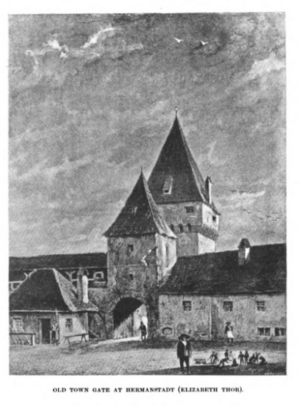Emily Gerard facts for kids
Quick facts for kids
Emily Gerard
|
|
|---|---|
| Born | 7 May 1849 Chesters, Jedburgh, Scotland |
| Died | 11 January 1905 (aged 55) Vienna, Austria |
| Occupation | writer |
| Language | English |
Emily Gerard (born May 7, 1849 – died January 11, 1905) was a Scottish writer from the 1800s. She is best known for her stories about Transylvanian folklore. These stories greatly influenced Bram Stoker when he wrote his famous 1897 novel, Dracula.
Contents
About Emily Gerard's Life
Her Early Years
Emily Gerard was born on May 7, 1849, in Chesters, Jedburgh, Scotland. She was the oldest daughter of Colonel Archibald Gerard and Euphemia Erskine. Emily had three sisters and three brothers. One of her sisters, Dorothea Gerard, also became a novelist.
In 1861, Emily lived with her family in Rochsoles House in Lanarkshire. They had many servants and visitors. From 1863 to 1866, Emily's family lived in Vienna, Austria. There, Emily became good friends with Princess Marguerite de Bourbon.
Emily was taught at home until she was 15 years old. After that, she studied European languages for three years. She went to a convent school called Sacré Coeur in Riedenburg, Austria. Emily and her sisters were raised Catholic, as their mother had become Catholic in 1848.
Her Writing Career
Emily and her sister Dorothea were active writers in the late 1800s. They worked together and also wrote their own books. Emily Gerard wrote stories for Blackwood's Magazine. She also reviewed French and German books for The Times newspaper and Blackwood's.
Working with Her Sister
In 1879, Emily Gerard started writing novels. Her first big work was with her sister Dorothea. They used the pen name E. D. Gerard. Their first novel together was Reata; or What's in a Name (1880). It was about a Mexican girl learning European ways. This book was published in Blackwood’s Magazine.
They wrote more novels together for the same magazine. These included Beggar My Neighbour (1882) and The Waters of Hercules (1885). Their collaboration stopped when Dorothea got married and moved away. Dorothea married an Austro-Hungarian officer and lived much of her life in Austria.
How Marriage Changed Her Writing
On October 14, 1869, Emily married Ritter Miecislaus von Laszowski in Salzburg. He was a Polish officer in the Austro-Hungarian Army and 20 years older than her. Emily had two sons. Her sisters joined her in 1870 after their mother passed away.
Because both sisters married officers, their later novels were often set in Eastern Europe. The Gerard family, including their brothers, wrote almost 60 books in total. After her marriage, Emily was sometimes called Emily Gerard, Mrs de Laszowska, or Emily de Laszowska Gerard.
Writing on Her Own
Emily Gerard's novels often featured characters and places from Europe. She spent time in Hermannstadt and Kronstadt. This helped her write about the culture and landscape of Transylvania. She learned about Transylvanian folklore when her husband was stationed there from 1883 to 1885.
Her book The Land Beyond the Forest (1890) and her essay "Transylvania Superstitions" are very important. They are believed to have inspired Bram Stoker to write Dracula. Her essay also introduced Stoker to the word "Nosferatu," which means the undead.
Some ideas from her writings, like local people being suspicious of vampires, clearly appear in the first part of Dracula.
Her Friendship with Mark Twain
In 1897, Emily Gerard wrote to William Blackwood, who ran Blackwood's Magazine. She asked to meet the American author Mark Twain. Blackwood helped them meet, and Emily Gerard became friends with Mark Twain. She even dedicated her book The Extermination of Love (1901) to him.
Emily Gerard wrote that Mark Twain was "an excessively serious, almost solemn person." But she also said that "when one can get him in the right vein he is quite fascinating."
Her Final Years
Emily Gerard passed away on January 11, 1905, in Vienna, Austria. She and her husband had moved there after he retired from the army. She was buried two days later. Her sister Dorothea also moved to Austria and lived a quiet life after her husband died.
What People Thought of Her Writing
During her lifetime, Emily Gerard was seen as a travel writer. She had a lot of experience in European countries and was very good at languages. In 1888, a review in Woman's Exponent called her "a clever writer." It said she was "rather cosmopolitan in her tastes," meaning she liked many different cultures.
A writer named A.S. Levetus wrote about Emily Gerard in 1905. She said Emily had "a fertile imagination" and a "rich gift of language." She could speak and write many foreign languages as well as her own.
However, some people felt that other members of her family, like her sister Dorothea, were more popular novelists. In 1905, newspapers like The Times and The Atheneum mentioned this. The Times said Emily "had not won equal popularity with that of her sister." But The Atheneum still called her "a capable novelist, with an excellent gift for telling a story."
Her Books
- Reata; or What's in a Name (1880)
- Beggar My Neighbour (1882)
- The Waters of Hercules (1885)
(These first three novels were written with her sister Dorothea Gerard under the name "E.D. Gerard.")
- "Transylvanian Superstitions." The Nineteenth Century (1885)
- The Land Beyond the Forest: Facts, Figures, and Fancies from Transylvania (1888)
- Bis (1890)
- A Secret Mission (1891)
- A Sensitive Plant (1891) (with Dorothea Gerard as "E.D. Gerard.")
- The Voice of a Flower (1893)
- A Foreigner; An Anglo-German Study (1896)
- An Electric Shock (1897)
- Tragedy of a Nose (1898)
- The Extermination of Love: A Fragmentary Study in ... (1901)
- The Heron's Tower: A Romance (1904)
- Honour's Glassy Bubble, A Story of Three Generations (1906) (Published after she died.)
Most of her solo works were listed as by "E. Gerard" on the title pages.


